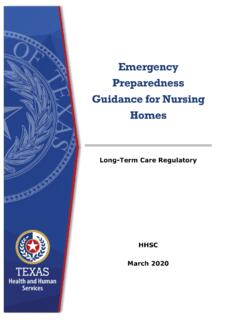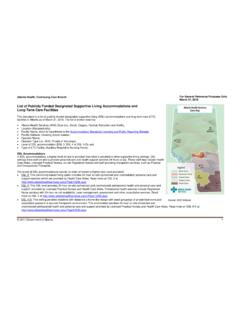Transcription of Center for Clinical Standards and Quality/Quality, Safety ...
1 DEPARTMENT OF HEALTH & HUMAN SERVICES. Centers for Medicare & Medicaid Services 7500 Security Boulevard, Mail Stop C2-21-16. Baltimore, Maryland 21244-1850. Center for Clinical Standards and Quality/Quality, Safety & Oversight Group Ref: QSO-20-03-NH. DATE: November 22, 2019. TO: State Survey Agency Directors FROM: Director Quality, Safety & Oversight Group SUBJECT: Updates and Initiatives to Ensure Safety and Quality in Nursing Homes Memorandum Summary The Centers for Medicare & Medicaid Services (CMS) is announcing updates and initiatives aligning with the CMS strategic initiative to Ensure Safety and Quality in Nursing Homes. These updates and initiatives include: Phase 3 Interpretive Guidance: CMS will be releasing updated Interpretive Guidance and training for the Requirements for Participation for long -Term care (LTC) Facilities.
2 However, this guidance will not be released by the November 28, 2019 implementation date of the regulations. We will be releasing the guidance in the second quarter of calendar year 2020, along with information on training and implementing related changes to The long Term care Survey Process (LTCSP). While the regulations will be effective, our ability to survey for compliance with these requirements will be limited until the Interpretive Guidance is released. Medicare and Medicaid Programs; Revision of Requirements for long -Term care Facilities: Arbitration Agreements: On July 18, 2019, the Department of Health and Human Services (HHS) published a final rule establishing requirements related to the use of binding arbitration agreements.
3 This final rule amends the requirements that long -Term care (LTC) facilities must meet to participate with Medicare and Medicaid. The final rule can be found at: Actions to Improve Infection Prevention and Control in LTC Facilities: CMS has created a nursing home antibiotic stewardship program training; updated the Nursing home Infection Control Worksheet as a self-assessment tool for facilities; and is reminding facilities of available infection control resources. Release of Toolkit 3, Guide to Improving Nursing home Employee Satisfaction : CMS has created a toolkit that helps facilities improve employee satisfaction. CMS continues to take action to improve and protect the health and Safety of nursing home residents.
4 This memo provides updates on these efforts. Page 2 State Survey Agency Directors Phase 3 Interpretive Guidance While the Phase 3 requirements will be effective November 28, 2019, and facilities are required to comply with these and all requirements, our ability to survey for compliance with these requirements will be limited until the Interpretive Guidance is released. We will be releasing the guidance in the second calendar quarter of calendar year 2020, along with information on training and implementing related changes to The long Term care Survey Process (LTCSP). Arbitration Agreements: On July 18, 2019, CMS published a final rule establishing new requirements related to the use of arbitration agreements by LTC facilities ( 18/ ).
5 This revises the Requirements for Participation for LTC facilities at 42. CFR (n). This final rule aligns with CMS' strategic initiative to increase transparency in nursing homes, by empowering consumers and their families to make informed decisions and choices that are best for them. The requirements for arbitration agreements are effective on September 16, 2019 and facilities are required to comply with this and all requirements. CMS intends to publish interpretive guidance for surveyors in the upcoming weeks as we do further research, obtain stakeholder feedback, and update the surveyor software to ensure the final guidance and process is comprehensive and effective.
6 Actions to Improve Infection Prevention and Control In light of recent reports of healthcare-associated infections in nursing homes, such as adenovirus and Candida auris, facilities are reminded of their responsibility for an effective infection prevention and control program to mitigate the onset and spread of infections. Basic practices include: Appropriate hand hygiene. As a reminder, alcohol-based handrub (ABHR) should be used instead of soap and water in all Clinical situations except when hands are visibly soiled ( , blood, body fluids), or after caring for a resident with known or suspected C. difficile or norovirus infection during an outbreak; in these circumstances, soap and water should be used.
7 Facilities should ensure adequate access to ABHR since a main reason for inadequate hand hygiene adherence results from poor access;. Appropriate use of personal protective equipment (PPE). Facilities need to ensure sufficient access and use of PPE, such as gowns and gloves in resident care areas/near the entrance to resident rooms, and appropriate education about the importance of PPE;. Environmental cleaning and disinfection. Clean and disinfect the resident's care environment and shared equipment with agents effective against the identified organism or products on an EPA-registered antimicrobial list recommended by public health authorities. It is important to follow all manufacturer's directions for use for a surface disinfectant including applying the product for the correct contact time.
8 Facilities need to ensure adequate access to supplies and proper instruction for staff (nursing or housekeeping/environmental services) responsible for cleaning pieces of equipment;. Implementation of transmission-based precautions when indicated;. Providing adequate surveillance and identification of resident diagnoses of infections or multidrug-resistant organism (MDRO) colonization status admitted to your facility to understand the types of infections and causative agents present; and Identifying and communicating at the time of transfer into and out of a facility the infection and/or MDRO colonization status of residents so appropriate measures can be implemented.
9 Page 3 State Survey Agency Directors Additionally, we strongly encourage the use of available technical resources, especially when novel organisms appear or there is an outbreak in your area. In many cases the Centers for Disease Control and Prevention is the first entity to release information on novel organisms. Your local and state health department may also be a resource on information specific to the prevalence of a specific organism in your area and actions to take. All facilities must comply with state and local public health authority requirements for identification, reporting, and containing communicable diseases and outbreaks. Many infection prevention and control resources are available to you to prevent and control infections in your facility.
10 These include, but are not limited to: Centers for Disease Control and Prevention. For example, infection prevention and control information for C. auris is currently located at: , and resources for nursing homes, including information about the Nursing home Infection Preventionist Training Course is available at: ;. Healthcare-associated infection and antibiotic resistance (HAI/AR) programs in local and state health departments. These programs offer numerous resources directed at improving infection prevention practices and preventing the spread of antibiotic resistant organisms, including performing on-site infection prevention assessments at nursing homes.












